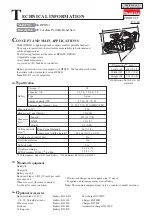
43
English
FIG. 18
F
CC
DD
BB
L
G
JJ
RIP FENCE INDICATOR ADJUSTMENT (Calibrating Rip Scale) (FIG. 18)
NOTE:
The rip fence indicator (L) points to the scale on the front of the table saw. Measurement
shown by the indicator will provide the user with accuracy up to 1/16 inch (1.6 mm ).
1. Measure the distance from the blade to the side of the fence closest to the blade. If there
is a difference between the measurement and the indicator reading, adjust the indicator.
2. Loosen the rip fence indicator screw (CC). Slide the rip fence indicator (L) to the correct
measurement position on the scale, then retighten the screw (CC).
TABLE EXTENSION SCALE POINTER (FIG. 19)
The table extension scale pointer (MM) should be at 10-1/2" (266.7 mm) on the scale when
the extension is in the closed position. If not, loosen the holding screw (LL), position the pointer
over 10-1/2" (266.7 mm) and re-tighten the screw.
ADJUSTING CAM LOCKING LEVER (FIG. 3, 20)
If the extension table moves when it is open and locked, then the cam locking lever (P) may
be loose and need adjustment, therefore, adjustment to the cam locking lever is necessary.
To adjust the locking lever tension, turn the bar (NN) with a 10 mm wrench until it is tightened,
but do not over tighten.
FIG. 19
MM
LL
FIG. 20
NN
ADJUSTING THE 90° AND 45° POSITIVE STOPS (FIG. 3, 21, 22)
This saw has positive stops that will quickly position the saw blade at 90° and 45° to the table.
Make adjustments only if necessary.
90° Stop
1. Raise the saw blade arbor to its maximum height by turning the blade height/bevel
adjustment wheel (I) clockwise.
2. Unlock the bevel lock lever (J), push in and turn blade height/bevel adjustment wheel (I) to
move the blade (C) to the maximum vertical position. Lock the bevel lock lever (J).
PP
FIG. 21
OO
C
FIG. 22
3. Place a combination square (OO) on the table and against the blade (C) to determine if the
blade is 90° to the table.
4. If the blade is not 90° to the table, loosen or tighten (depending on whether you are
increasing or decreasing the degrees) the hex bolt (PP) with a 5 mm hex wrench until you
achieve 90°.
5. Unlock the bevel lock lever (J), push in and turn blade height/bevel adjustment wheel (I) to
move the blade (C) to the maximum vertical position. Lock the bevel lock lever (J).
6. Recheck the blade to ensure it is 90° to the table. If not, repeat step 4.
7. Ensure the blade bevel pointer reads 90°. If the pointer does not read 90°, refer to
Blade
Bevel Pointer
paragraph.
45° Stop
1. Raise the saw blade arbor to its maximum height by turning the blade height/bevel
adjustment wheel (I) clockwise.
2. Unlock the bevel lock lever (J), push in and turn blade height/bevel adjustment wheel (I) to
move the blade to the maximum bevel (45°) angle.
3. Place a combination square (OO) on the table and against the blade (C) to determine if the
blade is 45° to the table.
4. If the blade is not 45° to the table, loosen or tighten (depending on whether you are
increasing or decreasing the degrees) the hex bolt (QQ) with a 5 mm hex wrench until you
achieve 45°.
5. Unlock the bevel lock lever (J), push in and turn blade height/bevel adjustment wheel (I) to
move the blade to the maximum bevel (45°) angle.
6. Recheck the blade to ensure it is 45° to the table. If not, repeat step 4.












































